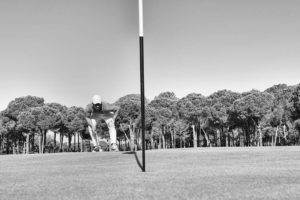Possibly the most critical skill you will have to learn in golf is how to hold your golf putter. In any golf event, putting might just be the most stressful part.

This is because most of the time, he who makes the best putt wins. Now, the first step on how to be a better putter in golf would be to understand the basics.
This article will discuss the different grips you can try and give some tips on how to become a great putter in golf. As a bonus, this article will also let you in on what is a belly putter in golf.
How to hold your golf putter
Every golfer may have a different technique of holding a golf putter.
The important thing when putting is to find accuracy in your strokes. As such, golfers generally experiment to see which grip would give them the most control when putting.
However, there are some common grips you can try while figuring out how to hold your golf putter.
Beginners usually find their choice of grip in one of the following: the reverse overlap grip, the cross-hand grip, or the claw grip.
Reverse Overlap
The most common putter grip is the reverse overlap.
Follow the procedure below to know how to hold your putter with a reverse overlap grip.
- Position your left hand onto the grip of your putter. Make sure your thumb is facing down towards the clubface.
- Put your right hand just below your left, thumb facing down.
- Lift your left index finger and rest it over your right fingers to link both hands.
Step 3 might feel unnatural for you if you are used to the normal overlap grip. In the standard overlap grip, the right pinky finger rests on the left index finger.
While this overlap grip allows your arms to move together for a full shot, the reverse overlap ensures you have more control of your arms for a steadier shot.
Cross-hand
The cross-hand grip is also called the “left-hand low” because the left-hand rests below the right. This grip allows the player to control their right arm if it becomes too active while hitting.
Here is how to do the cross-hand grip:
- Wrap your right hand around the handle near the top of your putter. You may experiment on the exact location to place your hand. For starters, you can put it at the very top.
- Place your left hand right below the right hand. Ensure that there is no space between your left pinky and your right forefinger.
- To link both hands, you can place your right index finger between your left pinky and ring fingers. Another option is to put your right forefingers over the left fingers.
There are two advantages to the cross-hand grip. First, it takes some of the control out of your dominant hand. Naturally, this would make your stroke more accurate.
Second, it squares your shoulders so that the putter head faces the ball more correctly.
Claw
If it is hard for you to control the strength of your right hand during a swing, you might want to try the claw grip.
In this grip, you’re basically managing the club with your non-dominant hand. Your dominant hand would just provide some stability.
To get an idea on how to hold your golf putter with a claw grip, follow the steps below.
- Wrap your left hand around the grip of your putter.
- Place your right hand under the left, with the knuckles facing out and the palm open.
- Position the shaft in between your right thumb and pointer finger.
- Wrap your thumb backward around the shaft and let the other fingers rest.
While this grip may look weird and feel uncomfortable, it can be very effective. Because of the position of your right hand, you prevent unnecessary motions on your wrists.
This then ensures that you can control and direct your shot.
How to become a great putter in golf
A lot of golfers have a hard time putting. Sometimes, one of the greatest frustrations of even the best golfers is how to be a better putter in golf. To help you out, here are some areas you can look at.
Technique
For some golf clubs, the most important considerations are speed and distance. To achieve this, you maintain a particular posture and technique in hitting the ball.
When putting, the biggest consideration might be accuracy. As you are hitting the ball from a close distance, you want to be in control of your putter.
To achieve this, you can start by focusing control on your hands and not your arms. Your arms might provide too much pressure and weight, causing the ball to go farther than you intended.
Practice
As they always say, practice makes perfect. And the same goes for putting. Practice can help you understand your strengths and weaknesses. And that can make you realize how to become a great putter in golf.
A simple practice of the different standard grips can be just what you need. Find out which best suits you. At the end of the day, what works for you may not be what you’re used to.
Experiment and find what you’re most comfortable putting with.
Equipment
If nothing else works, try checking your equipment. A simple change in your putter might just be your answer to how to be a better putter in golf.
For example, depending on your stroke, you may be better off using a face-balanced putter over a toe-balanced putter.
A face-balanced putter has a center of gravity right below the axis of the shaft and is recommended for straight strokes.
A toe-balanced putter, on the other hand, is recommended for those with an arc on their strokes. You can also look at the putter head. Blade putters are the most common ones but are generally recommended for straight strokes.
Peripheral weighted putters can be more forgiving and have more space for customization.
Then there are the mallet putters, which have lower centers of gravity but higher moments of inertia. As such, they are generally recommended for straight strokes.
Another piece of equipment that might work for you is something called the belly putter.
What is a belly putter in golf?
The belly putter is called as such because the end of its shaft used to be anchored at the belly. However, anchoring has actually been banned in golf.
To define “anchoring,” it is when the end of a shaft is leaning against the player’s body to create an “anchor point” during a stroke.
With this ban, however, the belly putter remains to be legal in golf. But what is a belly putter in golf, and how is it different from other putters?
The belly putter has a shaft that extends beyond the hands to grip the putter. The length of the shaft reaches the belly, which can be helpful for stabilization and consistency.
In using a belly putter, you need to ensure that you have the right length.
To do this, find a standard putter and grip it as you would normally. Then measure from the ground, up the shaft, and up to the golfer’s belly. This is the length your belly putter should be.
Next, you need to know how to grip a belly putter.
In holding a belly putter, you can try the same grips discussed above. Then, the golfer can lean forward and brace the edge of the shaft to their forearm.
This can provide the much-needed stability when putting and can be the answer to how to become a great putter in golf.
Your Putter’s Importance
In conclusion, how to hold your golf putter might be the most critical part of your game. However, with the many ways you can grip a putter, you are bound to find what works best for you.
To do this, you need to practice and discover the technique that is best suited for putting. If all else fails, ensure that you are using the right equipment.
And finally, don’t forget that sometimes the most unusual grips can be the most effective.
More Information
Last Updated on December 4, 2023 by Paul Roger Steinberg





